Permaculture companion plants for Beet
| Image | Name | Data | Description | Actions |
|---|---|---|---|---|
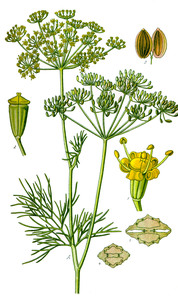
|
Anethum graveolens |
2-11
Full sun
Moist
Light (sandy), Medium
0.8
Annual
Herbs
Medium
15cm x 30cm
Essential Oil, Pest control, Fragrance
true
Leaves, Seed
Condiment, Tea
Dill
Apiaceae or umbelliferae
Algeria, Chad, Cyprus, Gulf States, Iran, Lebanon-Syria, Libya, Morocco, Oman, Saudi Arabia, Tunisia
Afghanistan, Alabama, Albania, Alberta, Altay, Andaman Is., Angola, Argentina Northeast, Arizona, Arkansas, Assam, Austria, Azores, Bahamas, Baleares, Baltic States, Bangladesh, Belarus, Belgium, Brazil South, Brazil Southeast, British Columbia, Bulgaria, California, Cameroon, Canary Is., Cape Verde, Cayman Is., Central European Rus, China North-Central, China South-Central, China Southeast, Connecticut, Costa Rica, Cuba, Czechoslovakia, Delaware, Denmark, Dominican Republic, East Aegean Is., East European Russia, East Himalaya, Ecuador, Eritrea, Ethiopia, Finland, France, Ghana, Great Britain, Greece, Guatemala, Haiti, Hawaii, Hungary, Illinois, India, Indiana, Iowa, Iraq, Italy, Jamaica, Kansas, Kazakhstan, Kentucky, Kenya, Kriti, Krym, Laos, Leeward Is., Louisiana, Madeira, Maine, Manitoba, Maryland, Massachusetts, Michigan, Minnesota, Missouri, Mongolia, Montana, Mozambique, Nebraska, Nepal, Netherlands, New Jersey, New York, Nicobar Is., Niger, Nigeria, North Carolina, North Dakota, Northwest European R, Norway, Ohio, Oklahoma, Ontario, Oregon, Pakistan, Palestine, Pennsylvania, Peru, Portugal, Primorye, Puerto Rico, Québec, Rhode I., Romania, Saskatchewan, Sicilia, Somalia, South Dakota, South European Russi, Spain, Sudan, Sweden, Switzerland, Tadzhikistan, Tanzania, Texas, Thailand, Transcaucasus, Trinidad-Tobago, Turkey, Turkey-in-Europe, Ukraine, Uzbekistan, Vietnam, Virginia, Wake I., Washington, West Virginia, Windward Is., Wisconsin, Yugoslavia
https://en.wikipedia.org/wiki/Dill
https://pfaf.org/User/Plant.aspx?LatinName=Anethum graveolens
https://powo.science.kew.org/taxon/urn:lsid:ipni.org:names:837530-1
Dill
|
Dill (Anethum graveolens) is a plant native to the eastern Mediterranean region and West Asia. It is an annual herb that grows to a height of about 1-2 feet and has delicate, feathery leaves. The plant has small yellow flowers that bloom in the summer. Dill is a popular herb in many cuisines, especially in European and Middle Eastern dishes. It is used to flavor soups, stews, fish, and pickles. The leaves and seeds of dill are both edible and can be used fresh or dried. The seeds have a more pungent flavor than the leaves and are often used in pickling. Dill can be stored by drying or freezing the leaves and seeds. Dill prefers full sun and well-drained soil. It is easy to grow and can be started from seed or from transplants. Dill is not winter hardy and will die off in the winter. In addition to its culinary uses, dill has been used medicinally to aid in digestion and to reduce inflammation. It has also been used as a natural insect repellent. The plant is attractive to many types of beneficial insects, making it a valuable addition to any garden. |
Show
Edit |

|
Lactuca sativa |
5-9
Annual, Biennial
Full sun, Partial sun/shade
Moist
Light (sandy), Medium
0.9
Herbs
true
Leaves, Seed
https://en.wikipedia.org/wiki/Lettuce
Garden lettuce
Asteraceae or compositae
Blattsalat
Oil
https://pfaf.org/User/Plant.aspx?LatinName=Lactuca sativa
Iraq
Alabama, Antipodean Is., Argentina Northeast, Assam, Austria, Baleares, Baltic States, Bangladesh, Belize, Bolivia, Bulgaria, Burkina, California, Cameroon, Canary Is., Cape Provinces, Cape Verde, Caroline Is., Central European Rus, Chad, China North-Central, Colombia, Connecticut, Corse, Costa Rica, Cuba, Cyprus, Czechoslovakia, Delaware, District of Columbia, Dominican Republic, East European Russia, East Himalaya, Ecuador, Egypt, El Salvador, Fiji, Finland, France, Free State, Germany, Great Britain, Guatemala, Haiti, Hawaii, Honduras, Hungary, Idaho, Illinois, Indiana, Inner Mongolia, Ireland, Italy, Jamaica, Jawa, Kazakhstan, Khabarovsk, Korea, Krym, Lebanon-Syria, Madeira, Maine, Marianas, Marshall Is., Massachusetts, Mauritania, Mauritius, Mexico Southeast, Michigan, Missouri, Myanmar, Nepal, Netherlands, New Guinea, New Hampshire, New Jersey, New Mexico, New York, Nicaragua, Niue, North Carolina, North Caucasus, North Dakota, North European Russi, Northwest European R, Ohio, Oklahoma, Oman, Ontario, Oregon, Pakistan, Panamá, Paraguay, Pennsylvania, Peru, Philippines, Poland, Portugal, Primorye, Puerto Rico, Rhode I., Romania, Réunion, Sardegna, Sicilia, South European Russi, Spain, Sweden, Switzerland, Taiwan, Transcaucasus, Trinidad-Tobago, Tubuai Is., Turkey, Turkey-in-Europe, Ukraine, Uzbekistan, Venezuela, Vermont, Vietnam, Wake I., Washington, West Virginia, Yugoslavia
30cm
https://powo.science.kew.org/taxon/urn:lsid:ipni.org:names:228239-1
Hair, oil, Pest control
|
Lettuce, Lactuca sativa, is a plant native to the Mediterranean region. It has green, elongated leaves that form a loose head. The stem is relatively short and the plant grows to a height of about 8-12 inches. Lettuce is a fast-growing plant, with some varieties able to be harvested in as little as 45 days. Lettuce can be differentiated from similar plants by its elongated leaves and loose head formation. It is also relatively short compared to other leafy green plants like kale and spinach. Lettuce prefers cool temperatures and grows best in full sun or partial shade. It is a hardy plant and can tolerate light frost, but will not survive extreme cold. To cultivate lettuce successfully, growers should ensure that the soil is well-drained and moist, and that the plants are spaced appropriately. Lettuce is edible and the leaves can be eaten raw in salads or cooked. The leaves can also be stored by washing and drying them, and then wrapping them in a damp paper towel before placing them in the refrigerator. Lettuce has a number of uses. It is a popular ingredient in salads and other dishes, and has been used medicinally to treat a variety of ailments, including insomnia and digestive issues. |
Show
Edit |
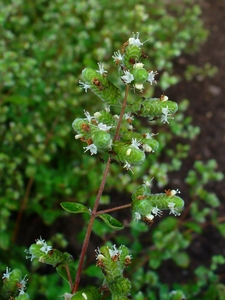
|
Marjoram |
6-9
Perennial
Full sun, Partial sun/shade
Dry, Moist
Light (sandy), Medium, Heavy (clay)
0.6
Herbs
true
Leaves
https://en.wikipedia.org/wiki/Marjoram
Lamiaceae or labiatae
Majoran
https://pfaf.org/User/Plant.aspx?LatinName=Origanum majorana
Cyprus, Turkey
Algeria, Azores, Baleares, Baltic States, Corse, Czechoslovakia, Great Britain, Greece, India, Italy, Juan Fernández Is., Krym, Libya, Madeira, Morocco, Spain, Switzerland, Tunisia, Ukraine, Venezuela, Yugoslavia
https://powo.science.kew.org/taxon/urn:lsid:ipni.org:names:453303-1
Condiment, Tea
Disinfectant, Dye, Essential Oil, Fragrance
|
Marjoram (Origanum majorana) is a herbaceous plant that is native to the Mediterranean region. It has delicate, oval-shaped leaves that are pale green in color, and small white or pink flowers that grow in clusters. The plant grows to a height of about 30 cm and has a woody stem. In terms of growing conditions, marjoram prefers well-drained, light soil and full sun to partial shade. It can be grown from seeds or cuttings, and should be spaced about 30 cm apart. Marjoram is winter hardy in mild climates, but may need to be protected or brought indoors in colder regions. Marjoram has a number of culinary uses. It is often used as a flavoring in soups, stews, and sauces, and can be added to salads and other dishes as a garnish. The leaves and flowers of the plant are edible and can be used fresh or dried. When harvesting marjoram, it is best to pick the leaves early in the morning when they are at their most flavorful. The leaves can be stored in an airtight container in a cool, dark place for up to six months. In addition to its culinary uses, marjoram has also been used medicinally as an antiseptic and as a remedy for digestive problems. It is also sometimes used in perfumes and soaps. Marjoram is not particularly attractive to wildlife, but it can provide habitat for some beneficial insects such as bees and butterflies. |
Show
Edit |
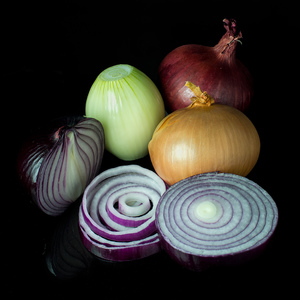
|
Allium cepa |
3-9
Annual
Full sun
Moist
Light (sandy), Medium
0.6
Herbs
Flowers, Leaves, Root, Seed
Seed - direct sow, Seed - transplant
https://en.wikipedia.org/wiki/Onion
Garden onion
Alliaceae
Zwiebel
https://pfaf.org/User/Plant.aspx?LatinName=Allium cepa
50°f, 10°c
Seed indoors 6 weeks before transplanting in the garden
2-6 inches
6.0-7.0
Allium
Turkmenistan
Algeria, Argentina Northeast, Arkansas, Baltic States, Bangladesh, Belarus, Bulgaria, California, Cambodia, Canary Is., Central European Rus, China North-Central, China South-Central, China Southeast, Colombia, Cuba, Czechoslovakia, Dominican Republic, East Aegean Is., East European Russia, East Himalaya, Ecuador, Egypt, Ethiopia, Fiji, France, Galápagos, Guinea-Bissau, Haiti, Illinois, India, Iraq, Italy, Jamaica, Kansas, Kentucky, Kirgizstan, Korea, Krym, Libya, Louisiana, Madeira, Manchuria, Mauritania, Mexico Central, Mexico Gulf, Mexico Northeast, Mexico Southeast, Mexico Southwest, Minnesota, Montana, Morocco, New York, Niue, North European Russi, Northwest European R, Oregon, Pakistan, Puerto Rico, Seychelles, South European Russi, Spain, Tadzhikistan, Texas, Thailand, Tibet, Tonga, Trinidad-Tobago, Ukraine, Uzbekistan, Vermont, Washington, West Himalaya, West Siberia, Wisconsin, Xinjiang, Yugoslavia
Spring or fall
0.3
https://powo.science.kew.org/taxon/urn:lsid:ipni.org:names:527795-1
Cosmetic, Dye, Hair, Polish, Rust
true
|
Onion (Allium cepa) is a plant species in the family Amaryllidaceae. It is native to central Asia and is commonly grown as a vegetable in many parts of the world. Onions are biennial plants, meaning they typically have a two-year life cycle. In the first year, the onion forms a small, rounded bulb with thin, papery skin. In the second year, the onion will produce a tall stem with hollow, elongated leaves and a small, spherical flower head. Onions are typically grown for their bulbs, which are used as a food ingredient in many dishes. The bulbs can vary in size and shape, depending on the variety, but are generally spherical or oblong in shape and range in size from about 2-4 inches in diameter. Onions are commonly differentiated by their color, which can range from white to yellow to red. Onions prefer well-drained soil that is rich in organic matter. They should be planted in a sunny location and will benefit from regular watering, especially during dry periods. Onion bulbs can be harvested when they reach the desired size, typically after about 100-150 days of growth. To store onions, they should be dried and cured in a cool, dry place for about two weeks before being placed in a mesh bag or other breathable container. Onions are edible and are commonly used as a food ingredient in many dishes. The bulbs are the most commonly used part of the plant, but the leaves and stems can also be used in cooking. Onions have a pungent, spicy flavor and are often used to add flavor to soups, stews, and other dishes. Onions can be stored for several months if properly dried and cured. In addition to their use as a food ingredient, onions have also been used for their medicinal properties. They have been used to treat a variety of ailments, including coughs, colds, and respiratory infections. Onions are also sometimes used as a natural fertilizer, due to the high levels of sulfur and other nutrients they contain. Onions are not known to provide significant value to wildlife. They are not a preferred food source for most animals and do not provide any significant habitat value. However, some insects, such as the onion maggot, can be pests of onion crops. |
Show
Edit |
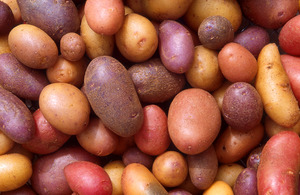
|
Potato |
3-10
Full sun
Moist
Light (sandy), Medium, Heavy (clay)
1.0
0.5
Perennial
12 inches
Seed - direct sow
April
Root
Irish potato, Andigena
Kartoffel
Solanaceae
Argentina Northwest, Argentina South, Bolivia, Chile Central, Chile North, Chile South, Colombia, Ecuador, Peru, Venezuela
Assam, Bangladesh, Belgium, Dominican Republic, East European Russia, East Himalaya, France, Great Britain, Haiti, Hawaii, Illinois, India, Ireland, Laos, Maryland, Minnesota, New York, South European Russi, Tadzhikistan, Uzbekistan, Vietnam, Zaïre
https://en.wikipedia.org/wiki/Potato
https://pfaf.org/User/Plant.aspx?LatinName=Solanum tuberosum
https://powo.science.kew.org/taxon/urn:lsid:ipni.org:names:821337-1
Rutin
Alcohol, Biomass, Cleanser, Cosmetic, Polish, Starch
true
|
Potato (Solanum tuberosum) is a herbaceous perennial plant that is native to the Andean region of South America. It is a member of the nightshade family (Solanaceae) and is closely related to other nightshades such as tomatoes, eggplants, and bell peppers. The potato plant has a bushy growth habit and can grow to heights of 30-150 cm depending on the variety. The leaves are large, heart-shaped, and alternate along the stem. The flowers are white or purple and have five petals. The plant produces small green berries that contain numerous seeds, but most varieties of potatoes are propagated vegetatively from tubers rather than from seeds. The edible part of the potato plant is the tuber, which is an underground stem that is modified for food storage. Potatoes come in a wide range of shapes, sizes, and colors including white, yellow, red, and purple. The size and shape of the tuber depends on the variety, with some varieties producing small, round tubers and others producing large, elongated tubers. Potatoes grow best in well-draining, fertile soils in a sunny location with a pH of 4.5-6.0. They require regular watering and should be planted in a location with good air circulation to prevent fungal diseases. Potatoes are typically planted from tubers that have been treated with a fungicide to prevent disease and are spaced 25-30 cm apart in rows that are 75-90 cm apart. The tubers will begin to form in the soil around 6-8 weeks after planting and can be harvested when they reach the desired size. Potatoes are a versatile and nutritious food source that is rich in vitamins, minerals, and fiber. The tubers are eaten cooked, baked, fried, or mashed, and the leaves and flowers of the plant can also be eaten. Potatoes can be stored in a cool, dry, and dark place for several months. Potatoes have a number of uses beyond their value as a food source. The tubers can be used as seed potatoes for planting, and the leaves and stems can be used as a natural insecticide or as mulch in the garden. In some parts of the world, potatoes are also used for their medicinal properties. Potatoes are a valuable food source for a variety of wildlife, including deer, rabbits, and squirrels. The flowers of the potato plant are also a source of nectar for bees and other pollinators. |
Show
Edit |
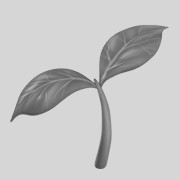
|
Beta vulgaris cicla |
4-8
Biennial
Full sun
Moist
Light (sandy), Medium, Heavy (clay)
0.9
true
Leaves, Stem
Chenopodiaceae
Swiss chard, silver beet, perpetual spinach, beet spinach, seakale beet, leaf beet
Mangold, krautstiel
https://pfaf.org/User/Plant.aspx?LatinName=Beta vulgaris cicla
2-3 years
|
Leaf vegetable. Leaves and stalks are edible. Closely related to the beet. |
Show
Edit |

|
Kohlrabi |
4-8
Full sun, Partial sun/shade
Moist
Light (sandy), Medium, Heavy (clay)
0.5
Annual, Biennial
Fast
true
Leaves, Stem
German turnip
Kohlrabi
Brassicaceae or cruciferae
https://pfaf.org/User/Plant.aspx?LatinName=Brassica oleracea gongylodes
|
Show
Edit |
|
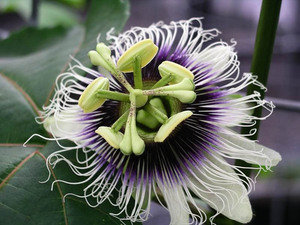
|
Passiflora edulis |
https://en.wikipedia.org/wiki/Passiflora_edulis
true
Fast
Moist
Full sun
9-12
Vines
Purple granadilla, passion fruit, granadilla, aul aanp, bai xiang guo, buah negeri, buah susu, garendal, granadiglia, granadilho, grenadille, ji dan guo, kudamonotokeiso, liliko'i, linmangkon, louki, magalendendele, maracuja-roxo, maracuya, markisa, maseche, matunda, munchi, obutunda, pasionaria, purpurgrenadille, qaranidila, sawarot, soh-brap, tikeiso, common passionfruit, fleur de la passion, flor de la pasión, granadiglia incarnata, granadilla, grenadella, kalala, maracayú, maracujá, maracujá azedo, maracujá-comum, maracujá-de-comer, maracujá-de-ponche, maracujá-do-mato, maracujá-doce, maracujá-mirim, maracujá-peroba, maracujá-preto, maracujá-redondo, maracuya, pasiflora, passiflora, passiflorae acetum folium, passiflore, passion flower, passion fruit, passion fruit|wel dodam, passionsblume, passionsfrukt, purple granadilla, purple passionflower
Light (sandy), Medium, Heavy (clay)
Passifloraceae
9.0
Oil, Drink, Sweetener
Weed potential
Fruit
Perennial
https://pfaf.org/User/Plant.aspx?LatinName=Passiflora edulis
Argentina Northeast, Brazil Northeast, Brazil South, Brazil Southeast, Brazil West-Central, Paraguay
Angola, Argentina Northwest, Assam, Azores, Bangladesh, Benin, Bolivia, Borneo, Brazil North, Burundi, Cambodia, Cameroon, Canary Is., Caroline Is., Central African Repu, China South-Central, China Southeast, Colombia, Comoros, Cook Is., Costa Rica, Cuba, Dominican Republic, East Himalaya, El Salvador, Ethiopia, Fiji, Florida, Gabon, Galápagos, Gambia, Gilbert Is., Guatemala, Gulf of Guinea Is., Hawaii, Honduras, India, Jamaica, Jawa, Kenya, KwaZulu-Natal, Laos, Leeward Is., Lesser Sunda Is., Malawi, Malaya, Marianas, Marshall Is., Mauritius, Mexico Central, Mexico Northeast, Mexico Southeast, Mexico Southwest, Morocco, Mozambique, New Caledonia, New South Wales, New Zealand North, Norfolk Is., Northern Provinces, Panamá, Peru, Puerto Rico, Queensland, Rodrigues, Réunion, Sri Lanka, Sudan, Swaziland, Taiwan, Tanzania, Thailand, Tonga, Trinidad-Tobago, Uganda, Venezuela, Victoria, Vietnam, West Himalaya, Windward Is., Zambia, Zaïre, Zimbabwe
https://powo.science.kew.org/taxon/urn:lsid:ipni.org:names:321964-2
Fencing, oil, Fragrance
|
Show
Edit |
|
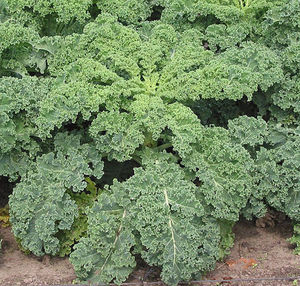
|
Kale |
5-10
Full sun, Partial sun/shade
Moist
Light (sandy), Medium, Heavy (clay)
6.0-6.8
Deciduous
0.9
Biennial, Perennial
Herbs
Fast
45cm
Seed - direct sow, Seed - transplant
At last frost date
4-6 weeks before last frost
7-10 days
3 to 7 years
Dynamic accumulator
true
Shoots
Brassicaceae, Cruciferae
True
https://en.wikipedia.org/wiki/Kale
https://pfaf.org/User/Plant.aspx?LatinName=Brassica oleracea acephala
Shallow
0.5 cm
60
|
Kale (/keɪl/) is a hardy, leafy green vegetable that is a member of the Brassica oleracea species. It is native to the eastern Mediterranean and Asia Minor, and has been cultivated for food for over 2000 years. Kale plants typically have green or purple leaves that are deeply lobed and can grow up to 2 feet in length. The leaves are attached to a central stem and don't make a head, and the plant produces small, yellow flowers. Kales are considered to be closer to wild cabbage than most of the many domesticated forms of Brassica oleracea. In terms of growing conditions, kale prefers cool weather and does well in full sun to partial shade. It can be grown year-round in mild climates, but in colder climates it is best grown in the fall and early spring. To cultivate kale successfully, it is important to provide the plants with plenty of moisture and to regularly fertilize them. Kale is also a good companion plant for other vegetables, as it can help to deter pests and improve the health of the soil. In terms of edibility, kale is highly nutritious and can be eaten raw or cooked. The leaves and stems are both edible, and the plant can be stored in the refrigerator for several days after harvest. Kale can be used in a variety of dishes, including soups, salads, and smoothies. It can also be cooked and served as a side dish, or used as a garnish. In addition to its culinary uses, kale has a number of other uses. It is often used as a cover crop, as it can help to improve the fertility of the soil. Kale leaves can also be used as a mulch, as they break down readily and release nutrients into the soil. Additionally, kale plants can be used for wind protection, as their large leaves and sturdy stems can provide a barrier to wind. ### Links [Kale @ West Coast Seeds](https://www.westcoastseeds.com/blogs/how-to-grow/grow-kale-collards) |
Show
Edit |

|
Brussel Sprouts |
Full sun, Partial sun/shade
Moist
Light (sandy), Medium, Heavy (clay)
1.2
0.2
Biennial
3 to 7 years
true
Leaves
Rosenkohl
Brassicaceae or cruciferae
https://pfaf.org/User/Plant.aspx?LatinName=Brassica oleracea gemmifera
|
A leaf vegetable in the cabbage family. |
Show
Edit |

|
Savoy cabbage |
7-11
Full sun, Partial sun/shade
Moist
Light (sandy), Medium, Heavy (clay)
0.8
Annual, Biennial
3 to 7 years
Dynamic accumulator
true
Leaves
Wirsing
Brassicaceae or cruciferae
https://pfaf.org/User/Plant.aspx?LatinName=Brassica oleracea sabauda
|
Savoy cabbage is a winter vegetable. The leaves can be eaten. |
Show
Edit |
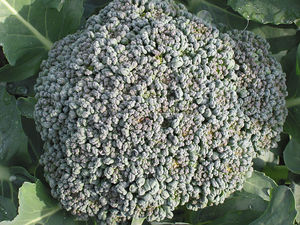
|
Broccoli |
2-11
Full sun, Partial sun/shade
Moist
Light (sandy), Medium, Heavy (clay)
6.0-7.0
0.9
Annual, Biennial
45cm
6-8 weeks before last frost
7-10 days
4°C (40°F)
50-100
3 to 7 years
Companion
true
Flowers, Leaves, Shoots
Brokkoli
Brassicaceae or Cruciferae
https://pfaf.org/User/Plant.aspx?LatinName=Brassica oleracea italica
|
Broccoli is a plant that is native to the Mediterranean region. It is part of the Brassica oleracea family, which also includes other vegetables such as cauliflower and cabbage. Broccoli plants have green, flowering heads that are similar in appearance to cauliflower. The stems are typically thick and can grow to be quite large, depending on the variety of broccoli. The leaves of the plant are typically dark green and are arranged in a spiral pattern along the stem. When it comes to growing conditions, broccoli prefers cool weather and well-draining soil. It is a relatively fast-growing plant, with the flowering heads typically forming in the first year. To cultivate broccoli successfully, a grower will need to make sure the plant gets enough water and sunlight, and provide it with the necessary nutrients through fertilization. In terms of winter hardiness, broccoli is not very frost-tolerant, so it is typically grown as a cool-season crop in areas with mild winters. In terms of edibility, broccoli is a very nutritious vegetable that is packed with vitamins and minerals. The flowering heads and the stems are both edible, and can be cooked in a variety of ways. After harvest, broccoli can be stored in the refrigerator for several days, or frozen for longer-term storage. ### Propagation - Direct sow Sow seeds 7cm apart, thin when seedlings reach 5-7cm in height. ### Propagation - Transplant Start seeds 6-8 weeks before your last frost date, or 2-3 weeks before last frost date. Plant outside when seedlings are 4-6 weeks old, or have 4-5 leaves. #### Links [Broccoli @ Almanac](https://www.almanac.com/plant/broccoli) |
Show
Edit |
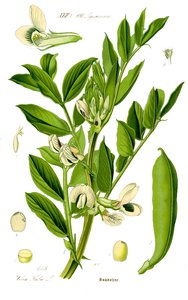
|
Broad Bean |
4-8
Full sun, Partial sun/shade
Moist
Light (sandy), Medium, Heavy (clay)
6.0-6.8
1.0
0.3
Annual
Fast
20cm
Seed - direct sow, Seed - transplant
6 weeks after sowing them in pots
6 weeks after sowing them in pots
21 days
3-5 years
Nitrogen fixer
Leaves, Seed
fava bean, faba bean, Broad bean, or faba bean Varieties with smaller, harder seeds that are fed to horses or other animals are called field bean, tic bean or tick bean Horse bean
Ackerbohne
Fabaceae or Leguminosae
Afghanistan, Iran
Albania, Algeria, Altay, Angola, Argentina South, Assam, Baleares, Bangladesh, Bolivia, Bulgaria, Cameroon, Canary Is., Central European Rus, Chad, China North-Central, China South-Central, China Southeast, Colombia, Corse, Cuba, Cyprus, Czechoslovakia, Dominican Republic, East Aegean Is., East European Russia, Ecuador, Ethiopia, France, Guatemala, India, Iraq, Italy, Jawa, Kenya, Krym, Lebanon-Syria, Leeward Is., Libya, Madeira, Mexico Southwest, Mongolia, Morocco, Myanmar, Nepal, New South Wales, New York, New Zealand North, New Zealand South, Pakistan, Peru, Portugal, Puerto Rico, Rwanda, Sardegna, Sicilia, Spain, Sri Lanka, Sudan, Tibet, Tunisia, Turkey, Turkey-in-Europe, Uruguay, Vermont, Vietnam, West Himalaya, Yemen, Yugoslavia
https://en.wikipedia.org/wiki/Vicia_faba
https://pfaf.org/User/Plant.aspx?LatinName=Vicia faba major
https://powo.science.kew.org/taxon/urn:lsid:ipni.org:names:524737-1
Feb-April; Oct-Nov
sow in deep pots in cool, frost-free place
|
Broad bean (Vicia faba), also known as fava bean or faba bean, is a type of legume that is native to North Africa and the Middle East. It is a popular garden plant, known for its edible beans and attractive purple or white flowers. Broad bean plants have a upright, bushy growth habit and can reach a height of up to 3 feet. The leaves are large and composed of three oval-shaped leaflets, and the flowers are small and clustered in groups of two or three. The beans are produced in long, slender pods that contain two or three beans each. To grow broad beans successfully, it is important to choose a location with well-drained, fertile soil and full sun. The plants should be spaced about 8-12 inches apart, and watered regularly to ensure that the soil stays moist but not waterlogged. Broad beans are generally easy to grow and require little maintenance, but they can be susceptible to pests and diseases, such as aphids and fungal infections. Grows best in temperatures ranging from 60° to 65°F (15-18°C) but will tolerate a range from 40°F (4.4°C) - 75°F (24°C). Broad beans are edible, and the beans can be eaten fresh or frozen, canned or dried for storage. To harvest the beans, the pods should be picked when they are plump and before the beans inside begin to harden. The beans can be removed from the pods by gently squeezing them out. Fresh beans can be stored in the refrigerator for a few days, while dried beans can be stored in an airtight container for several months. In addition to their culinary uses, broad beans also have a number of medicinal properties, and have been used to treat a variety of ailments, including asthma, bronchitis, and anemia. Broad beans are also a valuable food source for many types of wildlife, including birds, insects, and small mammals. The plants provide nectar for bees and other pollinators, and the beans are a popular food for many species of birds. |
Show
Edit |

|
Cucumis sativus |
9-11
Annual
Full sun
Moist
Light (sandy), Medium, Heavy (clay)
2
Vines
Fruit, Leaves, Seed
Seed - direct sow, Seed - transplant
1 week after last frost
https://en.wikipedia.org/wiki/Cucumber
Cucurbitaceae
Gurke
50-65
23cm
6.0-6.8
15-30°C (60-85°F)
https://pfaf.org/User/Plant.aspx?LatinName=Cucumis sativus
True
Fruit
Assam, Bangladesh, China South-Central, China Southeast, East Himalaya, Myanmar, Nepal, Thailand, West Himalaya
Alabama, Albania, Andaman Is., Arizona, Arkansas, Austria, Bahamas, Bolivia, Caroline Is., Cayman Is., Colombia, Costa Rica, Cuba, Czechoslovakia, Denmark, Dominican Republic, Ecuador, Florida, Georgia, Gulf of Guinea Is., Haiti, Illinois, India, Jamaica, Kansas, Kazakhstan, Kentucky, Korea, Laos, Leeward Is., Louisiana, Marianas, Marshall Is., Massachusetts, Michigan, Mississippi, Missouri, New Caledonia, New York, Nicaragua, Nicobar Is., North Carolina, North Caucasus, Ohio, Oman, Ontario, Pakistan, Pennsylvania, Pitcairn Is., Puerto Rico, South Carolina, Sri Lanka, Sweden, Tadzhikistan, Trinidad-Tobago, Turkmenistan, Utah, Uzbekistan, Venezuela, Vietnam, Virginia, Windward Is., Zaïre
2-3 weeks before last frost
1 week after last frost
0.9
https://powo.science.kew.org/taxon/urn:lsid:ipni.org:names:292296-1
Oil
Cosmetic, oil
true
|
Cucumber, scientific name Cucumis sativus, is a member of the gourd family. It is native to India and other parts of Asia. Cucumber is a trailing or climbing plant that grows to a height of 5-10 feet. The leaves are dark green and glossy, and the plant produces yellow flowers. The fruit of the cucumber plant is a long, green, edible vegetable with a thin skin. Cucumbers are typically about 6-9 inches long and 2-3 inches in diameter. In terms of growth and cultivation, cucumber plants prefer warm, sunny conditions and well-draining soil. They should be watered regularly, especially during dry periods. Cucumber plants are not winter hardy and should be grown in the summer months in most climates. To cultivate cucumbers successfully, it is important to provide them with adequate space to grow and to support the plants with trellises or other means to keep the fruits off the ground. The plant will develop male and female flowers. You can recognize the female by having a tiny cucumber underneath. Sometimes the plant develops a lot of male flowers first, so be patient. If you don’t see any bees pollinating. Take a male and put it on all the female flowers. Cucumber fruits are edible and can be eaten raw, pickled, or cooked. The skin and seeds of the cucumber are edible, but some people choose to remove the seeds before eating the fruit. Cucumber fruits can be stored in the refrigerator for a few days after harvest. Cucumbers have several uses. In addition to being eaten as a vegetable, they can also be used in a variety of dishes and salads. Cucumber slices are often used as a garnish or as a refreshing addition to beverages. Cucumbers are also commonly used in natural skin care products and are believed to have anti-inflammatory and soothing properties. #### Propagation Direct sow when soil is warm enough in early summer. Sow seeds individually indoors 3-4 weeks before planting outside into warm soil. Use bottom heat if possible. Transplant when plants develop third leaf. #### Medicinal Fruit is depurative, diuretic, emollient, purgative and resolvent #### Links [Cucumber @ West Coast Seeds](https://www.westcoastseeds.com/products/patio-snacker) |
Show
Edit |
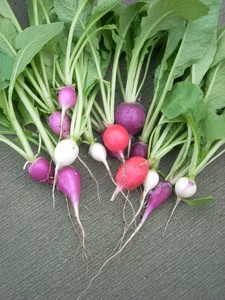
|
Raphanus sativus |
2-11
Full sun, Partial sun/shade
Moist
Light (sandy), Medium, Heavy (clay)
0.5
0.3
Annual
Roots
Fast
true
Flowers, Leaves, Root, Seed, Seedpod
Oil
Cultivated radish
Rettich
Brassicaceae or cruciferae
Greece, Italy, Sicilia, Yugoslavia
Alabama, Alaska, Algeria, Altay, Andaman Is., Angola, Argentina Northeast, Argentina Northwest, Argentina South, Arizona, Arkansas, Assam, Baleares, Baltic States, Bangladesh, Belarus, Belgium, Bermuda, Bolivia, Brazil South, Brazil Southeast, British Columbia, Bulgaria, California, Canary Is., Caroline Is., Central European Rus, Chile Central, Chile North, Chile South, China North-Central, China South-Central, China Southeast, Colombia, Colorado, Connecticut, Corse, Costa Rica, Cuba, Cyprus, Delaware, District of Columbia, Dominican Republic, East Aegean Is., East European Russia, East Himalaya, Ecuador, Egypt, El Salvador, Eritrea, Ethiopia, Fiji, Florida, Galápagos, Georgia, Gilbert Is., Guatemala, Gulf of Guinea Is., Gulf States, Hainan, Haiti, Hawaii, Idaho, Illinois, India, Indiana, Inner Mongolia, Iowa, Iraq, Japan, Jawa, Kansas, Kazakhstan, Kazan-retto, Kenya, Korea, Kriti, Krym, Kuwait, Labrador, Lebanon-Syria, Leeward Is., Libya, Louisiana, Madeira, Maine, Manchuria, Manitoba, Marianas, Marshall Is., Maryland, Massachusetts, Mauritania, Mexican Pacific Is., Mexico Northwest, Michigan, Minnesota, Mississippi, Missouri, Montana, Morocco, Nansei-shoto, Nebraska, Nepal, Nevada, New Brunswick, New Caledonia, New Hampshire, New Jersey, New Mexico, New South Wales, New York, Newfoundland, Nicobar Is., North Carolina, North Dakota, North European Russi, Northern Provinces, Nova Scotia, Ohio, Oklahoma, Oman, Ontario, Oregon, Pakistan, Palestine, Paraguay, Pennsylvania, Portugal, Primorye, Prince Edward I., Puerto Rico, Qinghai, Queensland, Québec, Rhode I., Rwanda, Sardegna, Saskatchewan, Saudi Arabia, South Australia, South Carolina, South Dakota, South European Russi, Spain, Sri Lanka, Sudan, Sumatera, Switzerland, Tadzhikistan, Tanzania, Tasmania, Texas, Tibet, Tunisia, Turkey, Turkey-in-Europe, Turkmenistan, Ukraine, Uruguay, Utah, Uzbekistan, Victoria, Vietnam, Virginia, Wake I., Washington, West Himalaya, West Virginia, Western Australia, Windward Is., Wisconsin, Wyoming, Xinjiang, Yemen, Zimbabwe
https://en.wikipedia.org/wiki/Radish
https://pfaf.org/User/Plant.aspx?LatinName=Raphanus sativus
https://powo.science.kew.org/taxon/urn:lsid:ipni.org:names:77159305-1
Weed potential
Animal feed, Cover crop, oil
|
The radish, also known as Raphanus sativus, is a plant native to southwestern Asia and the eastern Mediterranean region. It is a cool-season annual that grows quickly, often maturing in just a few weeks. The radish has a distinctive round or oblong shape, with a crisp and juicy texture. Its skin is typically red or white, but can also be purple, yellow, or black. The leaves of the radish are elongated and dark green in color, while its flowers are small and white or yellow in color. Radishes are relatively small, typically growing to be about four inches long and two inches wide. They prefer well-drained soil that is high in organic matter, and can be grown in a variety of climates, including temperate and subtropical regions. Radishes are typically differentiated from similar plants, such as turnips, by their smaller size and more pungent flavor. They can be harvested at any stage of their growth, but are typically harvested when they are young and tender for the best flavor. To cultivate radishes successfully, a grower will need to plant them in well-prepared soil, water them regularly, and thin out the plants to prevent overcrowding. Radishes are generally hardy and can tolerate frost, making them a good choice for a fall or winter garden. The edible parts of the radish plant are the root and the leaves. The root can be eaten raw, cooked, or pickled, while the leaves can be used in salads or cooked like other leafy greens. After harvest, the roots can be stored in a cool and dark place, such as a root cellar, to prolong their shelf life. Radishes have a number of uses, both in the garden and beyond. In the garden, they can be used as a companion plant to deter pests and improve the health of other plants. In addition to their use in cooking, radishes have also been used medicinally, with some evidence suggesting that they may have anti-inflammatory and digestive health benefits. Radishes are also a valuable food source for wildlife, providing a source of nutrition for birds and small mammals. They are a popular food for bees and other pollinators, and can help to attract these beneficial insects to the garden. |
Show
Edit |
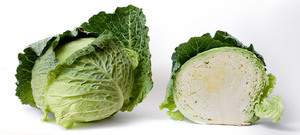
|
Cabbage |
7-11
Biennial
Full sun, Partial sun/shade
Moist
Light (sandy), Medium, Heavy (clay)
0.8
true
Leaves, Seed
https://en.wikipedia.org/wiki/Cabbage
Medium
Ornamental cabbage, red cabbage, savoy cabbage
Brassicaceae or cruciferae
https://pfaf.org/User/Plant.aspx?LatinName=Brassica oleracea capitata
3 to 7 years
Dye, Dynamic accumulator
|
Cabbage (Brassica oleracea capitata) is a biennial plant that is native to the Mediterranean region. It is a member of the Brassicaceae or mustard family and is closely related to other brassica crops such as broccoli, cauliflower, and Brussels sprouts. Cabbage is a leafy green plant that typically grows to about 1-2 feet in height. The leaves are large, thick, and vary in color depending on the variety of cabbage, with common colors including green, red, and purple. The plant produces small, yellow flowers that form in dense clusters at the top of the plant. Cabbage is a fast-growing plant that can be grown in a variety of conditions. It prefers well-draining soil that is rich in organic matter and full sun to partial shade. To successfully cultivate cabbage, a grower will need to water the plants regularly, especially during dry periods, and may need to use row covers to protect the plants from pests. Cabbage is an edible plant and all parts of the plant are edible. The leaves are the most commonly eaten part of the plant and can be eaten raw or cooked. The leaves can be stored in the refrigerator for several days after harvest. Cabbage can also be preserved by fermenting it to make sauerkraut or by pickling it. Cabbage is a valuable plant for gardeners and farmers because it is a nutritious and versatile food. It is high in vitamins C and K and contains significant amounts of dietary fiber. In addition to being eaten as a vegetable, cabbage can be used for medicinal purposes, as a fertilizer, and as a companion plant to repel pests in the garden. It is also a valuable food source for many species of wildlife. |
Show
Edit |
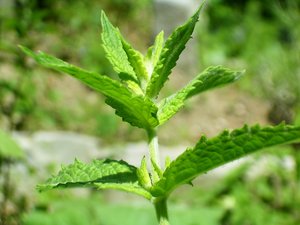
|
Spearmint |
3-9
Perennial
Full sun, Partial sun/shade
Moist
Light (sandy), Medium, Heavy (clay)
0.6
true
Leaves
https://en.wikipedia.org/wiki/Spearmint
Lamiaceae or labiatae
Weed potential
https://pfaf.org/User/Plant.aspx?LatinName=Mentha spicata
Afghanistan, Alaska, Albania, Alberta, Algeria, Altay, Amur, Angola, Arizona, Arkansas, Austria, Azores, Baleares, Baltic States, Belarus, Belgium, Botswana, British Columbia, Bulgaria, Buryatiya, California, Cambodia, Canary Is., Cape Provinces, Cape Verde, Central European Rus, Chad, Chatham Is., China North-Central, China South-Central, China Southeast, Chita, Colorado, Connecticut, Corse, Cyprus, Czechoslovakia, Delaware, Denmark, East Aegean Is., East European Russia, Egypt, Ethiopia, Finland, Florida, France, Free State, Føroyar, Georgia, Germany, Great Britain, Greece, Hungary, Iceland, Idaho, Illinois, India, Indiana, Inner Mongolia, Iowa, Iran, Iraq, Ireland, Irkutsk, Italy, Japan, Jawa, Kamchatka, Kansas, Kazakhstan, Kentucky, Kenya, Khabarovsk, Kirgizstan, Korea, Krasnoyarsk, Kriti, Krym, Kuril Is., KwaZulu-Natal, Labrador, Laos, Lebanon-Syria, Lesotho, Lesser Sunda Is., Libya, Madeira, Magadan, Maine, Malawi, Malaya, Maluku, Manchuria, Manitoba, Maryland, Massachusetts, Mexico Central, Mexico Northeast, Mexico Northwest, Michigan, Minnesota, Missouri, Mongolia, Montana, Morocco, Myanmar, Namibia, Nebraska, Nepal, Netherlands, Nevada, New Brunswick, New Hampshire, New Jersey, New Mexico, New South Wales, New York, New Zealand North, New Zealand South, Newfoundland, North Caucasus, North Dakota, North European Russi, Northern Provinces, Northern Territory, Northwest European R, Northwest Territorie, Norway, Nova Scotia, Ohio, Oklahoma, Ontario, Oregon, Pakistan, Palestine, Pennsylvania, Philippines, Poland, Portugal, Primorye, Qinghai, Queensland, Québec, Rhode I., Romania, Rwanda, Sakhalin, Sardegna, Saskatchewan, Saudi Arabia, Sicilia, Sinai, South Australia, South Dakota, South European Russi, Spain, Sri Lanka, Sudan, Sulawesi, Sumatera, Svalbard, Swaziland, Sweden, Switzerland, Tadzhikistan, Tanzania, Tasmania, Tennessee, Texas, Thailand, Tibet, Transcaucasus, Tunisia, Turkey, Turkey-in-Europe, Turkmenistan, Tuva, Uganda, Ukraine, Utah, Uzbekistan, Vermont, Victoria, Vietnam, Virginia, Washington, West Himalaya, West Siberia, West Virginia, Wisconsin, Wyoming, Xinjiang, Yakutskiya, Yugoslavia, Yukon, Zambia, Zimbabwe
Alabama, Amsterdam-St.Paul Is, Argentina Northeast, Argentina Northwest, Argentina South, Bangladesh, Bermuda, Bolivia, Brazil South, Caroline Is., Chile Central, Chile North, Chile South, Colombia, Comoros, Costa Rica, Cuba, District of Columbia, Dominican Republic, Eritrea, Falkland Is., Fiji, Galápagos, Gambia, Gilbert Is., Gulf of Guinea Is., Haiti, Hawaii, Juan Fernández Is., Louisiana, Marianas, Mauritania, Mexico Southwest, Mississippi, Niger, Norfolk Is., North Carolina, Oman, Prince Edward I., Puerto Rico, Society Is., South Carolina, St.Helena, Trinidad-Tobago, Tristan da Cunha, Uruguay, Venezuela
90cm
https://powo.science.kew.org/taxon/urn:lsid:ipni.org:names:30016176-2
Condiment, Tea
Essential Oil, Strewing, Fragrance
|
Spearmint, also known as Mentha spicata, is a perennial herb that is native to Europe and Asia. It is commonly used in cooking and as a medicinal herb. In terms of appearance, spearmint has bright green leaves that are pointed and serrated at the edges. The leaves are arranged in opposite pairs on square stems. The plant also has small, pink or white flowers that grow in clusters. Spearmint typically grows to be about 90cm tall and 90cm wide and spreads through underground rhizomes. Spearmint prefers moist, well-drained soil and full sun to partial shade. It is hardy in zones 5-9 and can be grown easily from seeds or cuttings. To cultivate spearmint successfully, a grower might need to prune the plant regularly to promote new growth and prevent it from becoming woody. Spearmint is edible and the leaves can be used fresh or dried in a variety of dishes. The leaves can also be made into a tea or infused into other liquids. The leaves can be stored in the refrigerator for up to a week or in the freezer for longer periods of time. Spearmint has a number of uses beyond its culinary value. The plant is known to have medicinal properties and is sometimes used to aid in digestion and to treat respiratory issues. It is also a natural insect repellent and can be used in the garden to deter pests. In addition, spearmint can be used as a ground cover or as a decorative plant in the garden. |
Show
Edit |

|
Cauliflower |
3-10
Full sun, Partial sun/shade
Moist
Light (sandy), Medium, Heavy (clay)
0.8
Annual, Biennial
3-7 years
Companion, antifungal, Dynamic accumulator
true
Flowers, Leaves
Blumenkohl
Brassicaceae or cruciferae
https://pfaf.org/User/Plant.aspx?LatinName=Brassica oleracea botrytis
|
Annual plant reproduced by seed. |
Show
Edit |
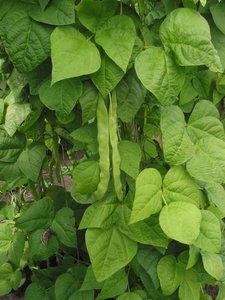
|
Common bean |
2-11
Annual
Full sun
Moist
Light (sandy), Medium, Heavy (clay)
2.0
Vines
Biomass, Dye, antifungal, Nitrogen fixer
true
Leaves, Seed, Seedpod
Seed - transplant, Seed - direct sow
https://en.wikipedia.org/wiki/Phaseolus_vulgaris
Pole bean, Climbing bean, French bean, Bush bean, Dwarf bean, Kidney bean, Green bean
Fabaceae, Leguminosae
Stangenbohne
https://pfaf.org/User/Plant.aspx?LatinName=Phaseolus vulgaris
16-18°c (70-80°f)
6.0-6.8
2.5 cm
16cm
4-10 days
45-85
Fast
Sperzieboon
Costa Rica, Guatemala, Honduras, Mexico Central, Mexico Gulf, Mexico Northeast, Mexico Northwest, Mexico Southeast, Mexico Southwest, Nicaragua, Panamá
Altay, Amur, Andaman Is., Angola, Argentina Northeast, Argentina Northwest, Assam, Baltic States, Bangladesh, Belarus, Bolivia, Bulgaria, Buryatiya, Cameroon, Cayman Is., Central European Rus, Chad, Chita, Colombia, Comoros, Cuba, Czechoslovakia, Dominican Republic, East European Russia, East Himalaya, Ecuador, Ethiopia, Guinea, Gulf of Guinea Is., Haiti, Illinois, India, Iraq, Irkutsk, Jamaica, Jawa, Kazakhstan, Kenya, Khabarovsk, Kirgizstan, Korea, Krasnoyarsk, Kuril Is., Leeward Is., Malaya, Marianas, Maryland, Mongolia, Myanmar, Nepal, New Guinea, New York, Nicobar Is., Nigeria, North Caucasus, North European Russi, Northwest European R, Pakistan, Peru, Philippines, Primorye, Puerto Rico, Queensland, Rwanda, Sakhalin, Senegal, South European Russi, Sri Lanka, Tadzhikistan, Tanzania, Thailand, Togo, Transcaucasus, Trinidad-Tobago, Turkmenistan, Tuva, Uganda, Ukraine, Uzbekistan, Venezuela, Vietnam, Wake I., West Himalaya, West Siberia, Yakutskiya, Zambia, Zaïre
2-4 weeks before last frost
1 week after last frost, 12-14 weeks before first frost
3-5 years
0.4
https://powo.science.kew.org/taxon/urn:lsid:ipni.org:names:514191-1
Coffee, Condiment
|
This entry describes all varieties of the common bean. This includes vining and bush/darf variaties and can have different names depending on their style of growths (see alternate names). These include the kidney bean, the navy bean, the pinto bean, the French bean and the wax bean The common bean, scientific name Phaseolus vulgaris, is a herbaceous annual plant native to the Americas, specifically the regions extending from the southwestern United States to South America. It is a member of the Fabaceae (legume) family. The common bean has a range of different appearances, depending on the variety. Most varieties have a simple, erect stem that grows to a height of 20-60 cm. The leaves are typically green and consist of 3-5 oblong leaflets. The flowers are small and white, pink, or purple in color. The fruit is a legume, which contains the seeds. The common bean is typically a small plant, but some varieties can grow to be quite large, reaching heights of up to 2 meters. The plant grows relatively quickly, with the growing season typically lasting between 60-100 days. The common bean prefers well-drained soil and full sun, but can also grow in partial shade. It is sensitive to frost and should be planted after the last frost date in the spring. To cultivate the common bean successfully, a grower may need to ensure that the soil is adequately fertilized and provide support for the plant to climb, if necessary. The common bean is edible, with the seeds and the young pods being the most commonly consumed parts. The seeds can be cooked and eaten as a protein-rich vegetable, and the young pods can be eaten as a green vegetable. The edible parts can be stored after harvest by drying the seeds or by preserving the young pods in vinegar or oil. The common bean has many uses beyond being a food source. The plant can fix nitrogen in the soil, improving its fertility and making it a useful companion plant for other crops. The dried leaves and stems of the common bean can be used as mulch or as a source of organic matter. In some cultures, the fibers from the stems are used to make ropes or other weaving materials. Additionally, the plant has been used medicinally to treat a variety of ailments. The common bean is also valuable for wildlife. The flowers attract bees and other pollinators, and the plant provides food for a variety of insects, birds, and small mammals. ### Links [Beans Seed Starting Tips @ Harvest to Table](https://harvesttotable.com/beans-seed-starting-tips/) ### Propagation - direct sow Direct-sow beans in spring after all danger of frost has passed and soil is at least 16°C (60°F). In warm-winter regions, sow beans in late summer for harvest in winter. Time sowing so that beans come to harvest before the first frost. |
Show
Edit |
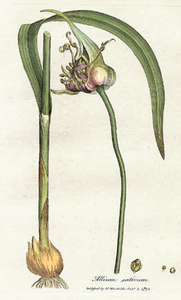
|
Garlic |
3-10
Perennial
Full sun
Dry, Moist
Light (sandy), Medium
0.6
Herbs
Flowers, Leaves, Root, Seed
Seed - direct sow
https://en.wikipedia.org/wiki/Garlic
Cultivated garlic
Alliaceae
Knoblauch
20cm
https://pfaf.org/User/Plant.aspx?LatinName=Allium sativum
6.5-7.0
Sting and itch relief from insect bites
Fibrous
Shallow
100-150
Allium
Iran, Kazakhstan, Kirgizstan, Tadzhikistan, Turkmenistan, Uzbekistan
Albania, Algeria, Amur, Austria, Baleares, Baltic States, Bangladesh, Belarus, Bulgaria, Cambodia, Canary Is., Central European Rus, China North-Central, China South-Central, China Southeast, Corse, Cuba, Czechoslovakia, Dominican Republic, East European Russia, Egypt, Ethiopia, France, Galápagos, Germany, Greece, Haiti, Hungary, Illinois, India, Iraq, Italy, Jamaica, Kentucky, Korea, Leeward Is., Libya, Mexico Central, Mexico Northwest, Mexico Southeast, Mexico Southwest, Morocco, New York, North European Russi, Northwest European R, Pakistan, Poland, Primorye, Puerto Rico, Romania, Sardegna, Seychelles, Sicilia, South European Russi, Spain, Switzerland, Tennessee, Thailand, Trinidad-Tobago, Tunisia, Turkey, Ukraine, Vermont, Wisconsin, Yugoslavia
Late autumn, Early spring
https://powo.science.kew.org/taxon/urn:lsid:ipni.org:names:528796-1
Adhesive, antifungal, Dynamic accumulator
true
|
Garlic (Allium sativum) is a bulbous perennial plant in the family Amaryllidaceae. It is native to central Asia and northeastern Iran, and has long been a staple in cuisines around the world. The plant has a distinctive appearance, with narrow, long leaves and a tall, hollow stem. The leaves are a pale green color and are attached to the stem in a spiral arrangement. The flowers are small and white, and are clustered in a spherical head at the top of the stem. Garlic plants can grow to a height of 30-150 cm (12-59 in), depending on the variety. They are relatively fast-growing plants, with the bulbs maturing in about seven months. Mulch for proper overwintering when planted in autumn. Garlic can be differentiated from other plants in the Allium genus by its distinctive flavor and aroma. It is also often distinguished by its long, narrow leaves and tall, hollow stem. Garlic prefers well-drained soil and full sun, and is typically grown from bulbs. To cultivate garlic successfully, growers should plant the bulbs in the fall, about 6-8 weeks before the first frost. The bulbs should be spaced about 10-15 cm (4-6 in) apart, with the pointed end facing up. After planting, the bulbs should be watered regularly and mulched to protect them from cold temperatures. Garlic is edible, with the bulbs and leaves being the most commonly eaten parts of the plant. The bulbs can be used fresh or cooked, and are often used as a seasoning in a wide variety of dishes. The leaves can be used fresh or cooked, and have a milder flavor than the bulbs. To harvest dig and do not pull out the bulbs. Let them dry in an airy, shady and dry spot e.g. by hanging them up. Once wrappers are dry, it can be stored at a dry place for several months. In addition to its culinary uses, garlic has a number of other uses. It is commonly used medicinally, as it has been shown to have antimicrobial and anti-inflammatory properties. It is also sometimes used as a natural insect repellent. In the garden, it can be used as a natural fertilizer, as it is believed to improve the soil and help deter pests. Garlic has value for wildlife, as it is attractive to a wide variety of pollinators, including bees, butterflies, and hummingbirds. It is also a food source for animals such as rabbits and deer. |
Show
Edit |

|
Nane |
Nana-minze
Afghanistan, Alaska, Albania, Alberta, Algeria, Altay, Amur, Angola, Arizona, Arkansas, Austria, Azores, Baleares, Baltic States, Belarus, Belgium, Botswana, British Columbia, Bulgaria, Buryatiya, California, Cambodia, Canary Is., Cape Provinces, Cape Verde, Central European Rus, Chad, Chatham Is., China North-Central, China South-Central, China Southeast, Chita, Colorado, Connecticut, Corse, Cyprus, Czechoslovakia, Delaware, Denmark, East Aegean Is., East European Russia, Egypt, Ethiopia, Finland, Florida, France, Free State, Føroyar, Georgia, Germany, Great Britain, Greece, Hungary, Iceland, Idaho, Illinois, India, Indiana, Inner Mongolia, Iowa, Iran, Iraq, Ireland, Irkutsk, Italy, Japan, Jawa, Kamchatka, Kansas, Kazakhstan, Kentucky, Kenya, Khabarovsk, Kirgizstan, Korea, Krasnoyarsk, Kriti, Krym, Kuril Is., KwaZulu-Natal, Labrador, Laos, Lebanon-Syria, Lesotho, Lesser Sunda Is., Libya, Madeira, Magadan, Maine, Malawi, Malaya, Maluku, Manchuria, Manitoba, Maryland, Massachusetts, Mexico Central, Mexico Northeast, Mexico Northwest, Michigan, Minnesota, Missouri, Mongolia, Montana, Morocco, Myanmar, Namibia, Nebraska, Nepal, Netherlands, Nevada, New Brunswick, New Hampshire, New Jersey, New Mexico, New South Wales, New York, New Zealand North, New Zealand South, Newfoundland, North Caucasus, North Dakota, North European Russi, Northern Provinces, Northern Territory, Northwest European R, Northwest Territorie, Norway, Nova Scotia, Ohio, Oklahoma, Ontario, Oregon, Pakistan, Palestine, Pennsylvania, Philippines, Poland, Portugal, Primorye, Qinghai, Queensland, Québec, Rhode I., Romania, Rwanda, Sakhalin, Sardegna, Saskatchewan, Saudi Arabia, Sicilia, Sinai, South Australia, South Dakota, South European Russi, Spain, Sri Lanka, Sudan, Sulawesi, Sumatera, Svalbard, Swaziland, Sweden, Switzerland, Tadzhikistan, Tanzania, Tasmania, Tennessee, Texas, Thailand, Tibet, Transcaucasus, Tunisia, Turkey, Turkey-in-Europe, Turkmenistan, Tuva, Uganda, Ukraine, Utah, Uzbekistan, Vermont, Victoria, Vietnam, Virginia, Washington, West Himalaya, West Siberia, West Virginia, Wisconsin, Wyoming, Xinjiang, Yakutskiya, Yugoslavia, Yukon, Zambia, Zimbabwe
Alabama, Amsterdam-St.Paul Is, Argentina Northeast, Argentina Northwest, Argentina South, Bangladesh, Bermuda, Bolivia, Brazil South, Caroline Is., Chile Central, Chile North, Chile South, Colombia, Comoros, Costa Rica, Cuba, District of Columbia, Dominican Republic, Eritrea, Falkland Is., Fiji, Galápagos, Gambia, Gilbert Is., Gulf of Guinea Is., Haiti, Hawaii, Juan Fernández Is., Louisiana, Marianas, Mauritania, Mexico Southwest, Mississippi, Niger, Norfolk Is., North Carolina, Oman, Prince Edward I., Puerto Rico, Society Is., South Carolina, St.Helena, Trinidad-Tobago, Tristan da Cunha, Uruguay, Venezuela
https://powo.science.kew.org/taxon/urn:lsid:ipni.org:names:30016176-2
|
Show
Edit |
|

|
Allium cepa ascalonicum |
4-8
Full sun
Moist
Light (sandy), Medium
5.0-7.0
0.3
0.2
Herbs
25cm, 10inch
Seed - direct sow
mid-Nov. - mid-March
Flowers, Leaves, Root
Alliaceae, Liliaceae
https://en.wikipedia.org/wiki/Shallot
https://pfaf.org/User/Plant.aspx?LatinName=Allium cepa ascalonicum
Cosmetic, Dye, Hair, Polish, Rust
true
|
Easy to grow vegetable that grow from a bulb. Edible parts are used for cooking. Exists in many varieties. Grows well in any fertile, well-drained soil at a sunny spot. Is started from seeds or sets (immature bulbs). Has a long growing period. |
Show
Edit |